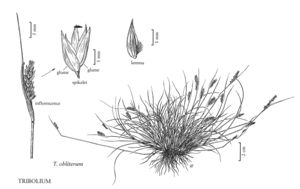Tribolium obliterum
Plants perennial; usually cespitose, sometimes stoloniferous, stolons to 30 cm. Culms 12-40 cm, decumbent or erect, branching intravaginal. Sheaths mostly glabrous, ciliate distally; ligules about 0.2 mm, membranous, ciliolate; blades 1-8 cm long, 0.5-1 mm wide. Inflorescences terminal, panicles, 1-5 cm long, 5-15 mm wide, obovate or cylindrical, with 10-40 spikelets; branches scabridulous. Spikelets 3.5-4.5 mm, with 5-10 florets. Glumes 2.5-3.5 mm, longer than the basal lemmas but exceeded by the distal florets, 5-veined, glabrous or scabridulous over the veins, acute; lemmas 2-3.5 mm, with submarginal tufts of hairs in the lower 1/2, hairs acute, 0.2-0.3 mm, lemma apices acute to acuminate; paleas 1.5-2 mm, glabrous between the keels, sometimes with tufts of hairs on the margins; anthers 0.3-0.5 mm, pale yellow. Caryopses obovate, 0.7-1 mm long, 0.5-0.7 mm wide, plano-convex to concavo-convex, pale brown, smooth; embryos 0.4-0.5 mm; hila 0.1 mm. 2n = 24, 36.
Discussion
Tribolium obliterum is native to Cape Province, South Africa, where it usually grows in gravelly, well-drained soils at elevations below 600 m. It has been introduced into Australia and St. Helena and was recently discovered in a roadside ditch near Fort Ord, Monterey County, California. It appears to be naturalized there.
Selected References
None.
